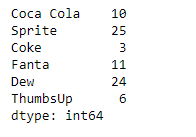Python | Pandas Series.nlargest()
Last Updated :
11 Feb, 2019
Pandas series is a One-dimensional ndarray with axis labels. The labels need not be unique but must be a hashable type. The object supports both integer- and label-based indexing and provides a host of methods for performing operations involving the index.
Pandas Series.nlargest() function return the n largest element from the underlying data in the given series object.
Syntax: Series.nlargest(n=5, keep=’first’)
Parameter :
n : Return this many descending sorted values.
keep : {‘first’, ‘last’, ‘all’}, default ‘first’
Returns : Series
Example #1: Use Series.nlargest() function to return the first n largest element from the given series object.
import pandas as pd
sr = pd.Series([10, 25, 3, 11, 24, 6])
index_ = ['Coca Cola', 'Sprite', 'Coke', 'Fanta', 'Dew', 'ThumbsUp']
sr.index = index_
print(sr)
|
Output :

Now we will use Series.nlargest() function to find the first 2 largest value in the given series object.
result = sr.nlargest(n = 2)
print(result)
|
Output :

As we can see in the output, the Series.nlargest() function has successfully returned the first 2 largest value in the given series object.
Example #2: Use Series.nlargest() function to return the first n largest element from the given series object.
import pandas as pd
sr = pd.Series([11, 21, 8, 18, 65, 84, 32, 10, 5, 24, 32])
print(sr)
|
Output :

Now we will use Series.nlargest() function to find the first 5 largest value in the given series object.
result = sr.nlargest(n = 5)
print(result)
|
Output :

As we can see in the output, the Series.nlargest() function has successfully returned the first 5 largest value in the given series object.
Like Article
Suggest improvement
Share your thoughts in the comments
Please Login to comment...